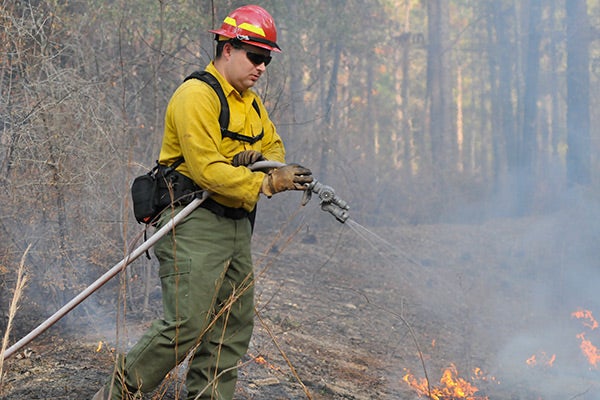Biologist: Fires are wake-up call
Published 10:25 am Saturday, December 3, 2016
Even as state officials reminded Alabamians that a statewide “no burn” order remains in effect, biologists called recent wildfires “wake-up calls,” and said fire is natural in Southern habitats.
Year-to-date, a total of 3,644 wildfires have consumed almost 50,000 acres of land in Alabama, with 2,219 of those fires and 29,406 acres just since Oct. 1. Devastation in the Great Smoky Mountains and Gatlinburg focused more attention on the potential for fires.
There have been no wildfires in Covington County in the past week, but 20 fires have damaged 19.25 acres in the last month.
Mark Bailey, a local wildlife biologist, shared a post from a colleague of his on Facebook that called recent wildfires a “wake-up call.”
“So many of us have forgotten (or never knew) that the vast majority of the habitats in the southeastern United States are fire-type habitats,” Robert Smith said. “The includes the pitch pine and Table Mountain pine stands in the southern Appalachians, the longleaf pine hills and ridges, the slash pine flatwoods, hardwood ridges and slopes, cane breaks in our bottomland hardwood stands, prairies, grassy depressional wetlands, tidal marshes and more. All of these habitats and those adjacent and between those habitats have the opportunity to burn historically.”
Smith went on to say that when fire conditions become extreme as they are now, they can spread and grow quickly, and places wind up with catastrophic wildfires.
“But society quickly forgets this lesson when the fires leave the headlines; they are not willing to invest in fuel reduction efforts, prescribed fire implementation or landowner education and ‘firewise’ landscaping.’
Bailey said Smith was “dead on.”
“The thing about our ancestors sweeping their yards bare demonstrates how fire was always at the back of our ancestors’ minds,” Bailey said. “Southeastern forests and fire are inseparable, although we have done our best to intervene. After decades of the ‘all-fire-is bad’ Smokey Bear mentality, land managers today embrace fire, recognizing that it’s not a matter of if, but when fire will occur. It can be beneficial and on our terms if we are wise, or catastrophic and uncontrollable if we are not.”
Bailey said that prescribed burning is necessary.
“We need to use prescribed fire if we want to maintain natural habitats and to reduce the risk of catastrophic fires like we just saw in Gatlinburg and also in Florida in the late 1990s,” he said. “I recall seeing aerial photos of houses in so-called ‘wildland-urban interface’ in Florida that were burned next to others that were spared, and the difference was there had been recent prescribed burns near the one that were unscathed. Reducing pine straw and woody debris fuels through periodic prescribed burning under desirable conditions can make all the difference in saving property, as well as stands of valuable trees that might be killed if unplanned fires get too hot. Of course, this needs to be done by people who are experienced and trained in using fire responsibly.”
Bailey said that Andalusia is the center of a once-vast longleaf forest ecosystem, which was naturally swept by fires every two to five years.
“The best remaining example we have near us is the Conecuh National Forest,” he said. “The native plants and animals have adaptations to survive fire. In fact, without fire, some of these species become imperiled. People nowadays think of gopher tortoises as animals of roadsides, power lines and fields, but that’s an artifact of fire suppression – they live where their food grows.”
Since Tim Mersmann has taken over as district ranger in the Conecuh National Forest, they have worked to ensure they burn around 30,000 acres per year to stay on track with burning the fire-maintained forest.
“We prescribe burn the forest to keep the undergrowth at a minimal height, which provides for food and habitat for all types of wildlife, including red cockaded woodpeckers, gopher tortoise and many game species, including deer and turkey,” Mersmann said previously.
Prescribed burns reduce the amount of hazardous fuels, which protect from wildfires.
The statewide Drought Emergency ‘No Burn’ Order declared by Gov. Robert Bentley in early November will remain in effect until conditions change sufficiently to reduce the occurrence and frequency of wildfires, the Alabama Forestry Commission announced Friday.
“We are grateful for the rainfall we’ve received, but because of the severe prolonged drought it is just too soon to lift the ‘No Burn’ Order,” explained Interim State Forester Gary Cole. “The winds and lower relative humidity accompanying the cooler temperatures we’re experiencing combine to quickly dry out vegetation, which will increase the probability of dangerous wildfire activity until the next rain event. We’re certainly hoping the weather forecast of additional rain through early next week is correct, and we will re-assess the situation at that time.”
Despite precautions, with the severe drought, the state isn’t taking any chances.
“After seeing the recent devastation in our sister state of Tennessee, we cannot afford to take any risks,” Bentley said.
The Drought Emergency ‘No Burn’ regulation prohibits all outdoor or open burning statewide. It makes it illegal for any person to set fire to any forest, grass, woods, wildlands or marshes; build a campfire or bonfire; or burn trash or debris. If convicted, the penalty for violating the No Burn Order is up to six months in jail and a fine of up to $500. To report persons burning in violation of this law, contact your local law enforcement. For more information on the current wildfire situation in the state, visit Alabama Forestry Commission’s website at www.forestry.alabama.gov.






